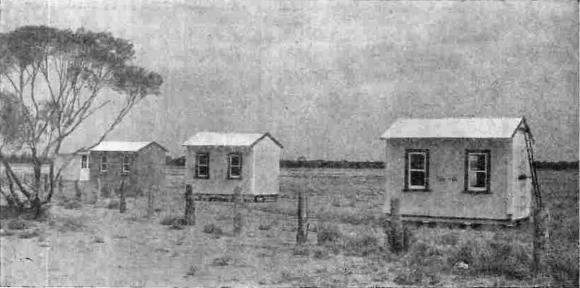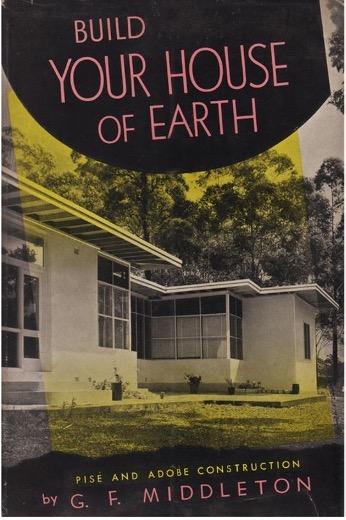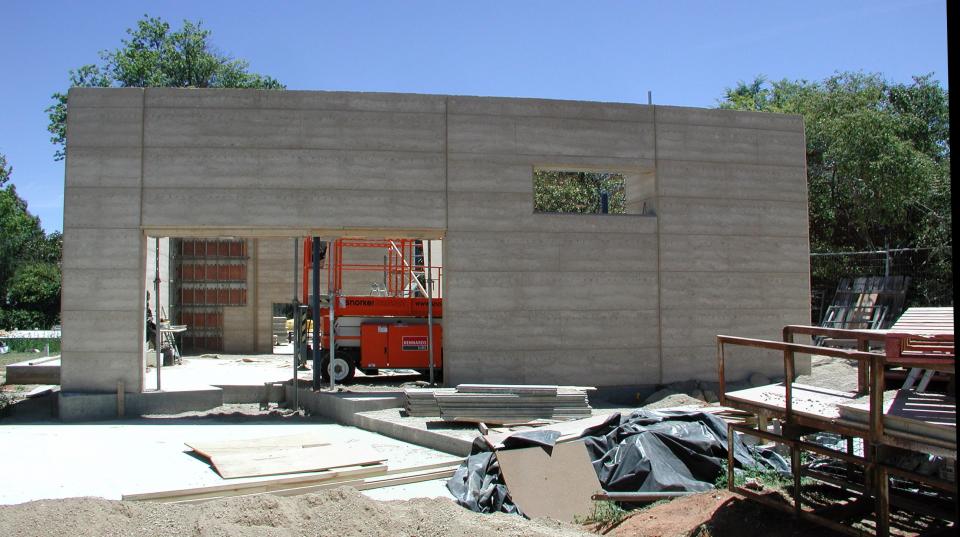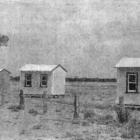Modern houses are increasingly designed to buffer us from the extremes of heat and cold. A belief held by both professionals and the public that a home can and should reflect the climate and location has waxed and waned over the twentieth century. However, research in housing adaptability has surprising origins. In a continent notorious for its extremes, the Australian government fostered an innovative center known as the Commonwealth Environmental Building Station (CEBS) in the immediate postwar period. Concerns about the environment led to an international drive to place a climatically defined framework over the layout and construction of homes. In Australia, government science linked technology, the environment, and domestic spaces by reviving the use of raw earth as a viable and adaptable building method.

Test huts in Mildura, circa 1946.
Test huts in Mildura, circa 1946.
J. W. Drysdale, “Climate and House Design: Summary of Investigations 1945–1947,” Duplicated Document, no. 21, June 1947, plate 2. Sydney: Commonwealth Experimental Building Station.
 This work is licensed under a Creative Commons Public Domain Mark 1.0 License.
This work is licensed under a Creative Commons Public Domain Mark 1.0 License.
Following the Depression and two major wars, the wartime Labour government faced a housing crisis, building-material shortages, and a growing population. As the magnitude of the crisis became clear, the Ministry of Post-War Reconstruction created a Small House Bureau in 1944 to reinvigorate the housing landscape. One of its directors, the celebrated modernist architect Robin Boyd, took an interest in pisé, meaning “earth in place.” Building with readily accessible local materials could help solve the housing crisis, Boyd wrote in his weekly newspaper column. It seemed reasonable to “make it of mud!” as earthen walls were “cheap, strong, weatherproof, and highly insulating.”
In 1944, the Ministry also created CEBS, located on 40 acres north of Sydney, to develop its scientific prowess across a range of technical industries. The first chief technical officer, English architect and engineer George Middleton arrived soon after in 1947. Middleton also brought a European mindset that saw the use of raw earth as a rational, traditional, yet thoroughly modern, building solution. As one of several technical solutions being pursued, CEBS championed the investigation of the structural and thermal qualities of earth as a “novel and progressive” means of building.

Classic modernist architecture on the cover of George F. Middleton, Build Your House of Earth: A Manual of Pise and Adobe Construction (Sydney: Angus and Robertson, 1953).
Classic modernist architecture on the cover of George F. Middleton, Build Your House of Earth: A Manual of Pise and Adobe Construction (Sydney: Angus and Robertson, 1953).
 This work is licensed under a Creative Commons Public Domain Mark 1.0 License.
This work is licensed under a Creative Commons Public Domain Mark 1.0 License.
The Station’s mandate was to carry out experimental construction in different climatic and geographical locations and advise regulators, housing authorities, and government departments. Engineers, builders, architects, and the public welcomed this innovative approach to housing and applauded the growing recognition of the relationship between climate and house design across the nation’s varied, extreme weather and seasonal conditions. One article from the Cobram Courier in 1949 exclaimed, “The fact that houses of similar design may be seen anywhere from Tasmania to Northern Australia, reveals the need for a more intelligent use of available building materials in alleviating the discomforts of climate.”
With a focus on “heating, lighting, ventilation, insulation, sound and thermal transmission, and performance generally,” CEBS’s research sparked a transnational push across Britain and its colonial outposts to elevate building reconstruction to a scientific footing. Its novel contribution was to conceive of climatic zones and to test scaled experiments across different regions with variations of insulation, window size, and concrete versus timber floors, which resulted in extensive quantitative data sets that could be applied to other parts of the globe.
EBS’s overall research output was extensive. Middleton’s fascination with raw earth resulted in over one hundred technical studies, reports, and papers focusing on its adaptability to the Australian landscape and extremes. Providing a nexus for innovative scientific research with similar experiments being undertaken in New Zealand, the US and Canada, and the UK, CEBS conceived of and sought to unite the modern with the vernacular in a way that tried to be accessible and cost-effective. Before Middleton left to take a post with the United Nations in 1952, Build Your House of Earth was released and remains the authoritative text on rammed earth construction in Australia.
The Building Station continued to provide regulation and standards until its closure in 1981. The high-water mark had faded as labor costs became prohibitive throughout the 1960s, and regulation hurdles proved too costly for mainstream building works. Continuing to evolve and professionalize, earth building has risen and fallen in line with design trends and economics. It remains a rational, though still bespoke, housing style due to outdated regulation requirements, which prefer prefabricated materials such as rigid insulation, and a lack of collated data on the enduring ability of natural materials to provide thermal comfort. Though the use of earth only momentarily preoccupied the agenda of engineers and bureaucrats, the work of CEBS directly addressed the problem of building efficiency twenty years before the energy-conservation movement emerged across the globalized North.

Modern rammed-earth (pisé) building in Canberra, 2018.
Modern rammed-earth (pisé) building in Canberra, 2018.
Accessed via Flickr.
 This work is licensed under a Creative Commons Attribution-ShareAlike 2.0 Generic License.
This work is licensed under a Creative Commons Attribution-ShareAlike 2.0 Generic License.
With climate change resulting in more frequent and extreme weather events, the assertion that we should, as best practice, build our houses to suit the prevailing winds, chill factors, sun exposure, seasonal shifts, and climate zone no longer seems radical. As we continue to struggle to build homes that can withstand the vagaries of a rapidly changing environment, Middleton’s research, and the work of CEBS serves as a pointed reminder of the potential and capacity of earth, even in an extreme and varied climatic continent such as Australia. The contribution of the Station, then internationally recognized for its innovation and experimentation, has been forgotten and its establishment overlooked as a critical moment when technology, climate, and habitation were momentarily occupying the popular agenda. Building regulators, architects, designers, and engineers have ignored the warning by CEBS of the danger of disregarding “the prevailing climatic conditions, and to the irrational use of traditional materials,” and generations of outmoded and inefficient housing stock reflect this oversight.
How to cite
Goldlust, Rachel. “‘Housing for a Changing Climate: The Commonwealth Environmental Building Station in 1950s Australia.” Environment & Society Portal, Arcadia (Spring 2023), no. 1. Rachel Carson Center for Environment and Society. doi:10.5282/rcc/9557.
ISSN 2199-3408
Environment & Society Portal, Arcadia
 This work is licensed under a Creative Commons Attribution 4.0 International License.
This work is licensed under a Creative Commons Attribution 4.0 International License.
2023 Rachel Goldlust
This refers only to the text and does not include any image rights.
Please click on an image to view its individual rights status.
- “Build to Climate.” Cobram Courier, 2 December 1949.
- Boyd, Robyn. “The Materials for Adobe Construction Are Already on Your Vacant Building Site. Make It of Mud!” The Age, 17 March 1948, Small Homes Section.
- Ryan, Daniel. “Thermal Nationalism: The Climate and House Design Program in Australia (1944–1960).” ABE Journal 18 (2021). doi:10.4000/abe.9848.
- Isaacs, David V., and J. W. Drysdale. Building Technique and Building Research: A Report on Investigations Made Abroad by the Director of the Station during 1947 and by a Senior Technical Officer in 1948. Sydney: Commonwealth Experimental Building Station, 1949.
- Howard, Ted. Mud and Man: A History of Earth Buildings in Australasia. Melbourne: Earthbuild Publications, 1992.
- Williamson, Terence J. “Designing Houses for the Australian Climate: The Early Research.” Architectural Science Review 56, no. 3 (2013): 197–207. doi:10.1080/00038628.2013.807218.








